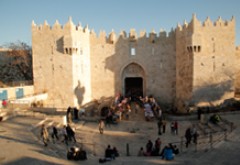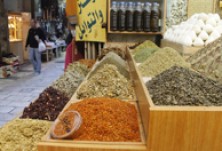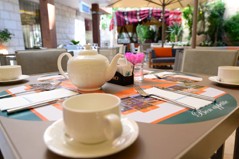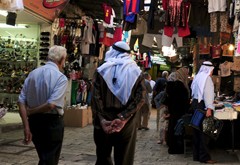This Sabil is located on the northern side of Bab al-Silsila immediately at the beginning of al-‘Ain (spring) steps connecting al-Wad Street and Bab al-Silsila Street. Access to it is easy, requiring a short walk along Bab al-Silsila Street until the first crossing to the right, namely, al-‘Ain steps crossing.
Al-Sabil Founder and the Khalidi Family
The founder who assigned this Sabil as a Waqf (religious endowment) is the pride of scholars and teachers, Muhammad San’allah al-Khalidi, son of Khalil al-Khalidi. The family name (al-Khalidi), the titles of the founder and those of his father as mentioned in the Waqf document indicate clearly that Muhammad San’allah al-Khalidi was a prominent dignitary of Jerusalem during that era. The roots of al-Khalidi family, as registered in the Waqf document, have a deep history into the early years of Islam and Khaled ibn al-Walid, the Prophet’s companion. The Khalidi family and its members had a pioneering role in the history of Jerusalem and Palestine. Many of its members assumed important, influential positions during and towards the end of the Ottoman period. Regarding the motives behind building the Sabil and who drinks from it, it was mentioned in the Waqf document that: ‘This Sabil was registered as a Waqf and its water was made available to gentelmen and all people, whether or residence or non-residence,e coming or going, and all people, purely for the countenance of Almighty Allah in wish for the great reward.’
Sabil’s Names and Plan
The Sabil is also known as Sabil Daraj al-‘Ain, or Sabil Daoud Road. Its plan is simple, composed of one room topped by a barrel vault. It was originally a store but was altered to serve as a Sabil. The interior is accessed through a door that is opened in its western wall, facing the eastern side of al-Jalqiyya mausoleum (1307 AD / 707H). On the southern side of the room is a wall with a double-window and a water trough from which passers-by took water. The Sabil stopped operating a long and unknown time ago, and the room has become a store used by al-Khalidi family.
The Sabil’s Servers and Simplicity
The founder was keen to appoint water supplier to provide water daily against a specific wage, and hence water was poured into the trough as needed and scooped in tin cans by people to quench their thirst. This water structure reflects the simplicity, or rather monotony and stagnation which characterized the architecture of Ottoman Jerusalem since the end of the 16th century, persisting until 1831. After the reign of Muhammad Ali Pasha in Jerusalem and Palestine and the return of the Ottoman reign, construction using traditional methods stopped, and modern European styles were adopted, which were markedly different from what was common in the Mamluk and Ottoman schools of architecture.
Similarity with Sabil Al-Shurbaji
Since this Sabil was established by a wealthy citizen of Jerusalem, as was the case with Sabil al-Shurbaji, there were common architectural and design characteristics connecting the two Sabils, in addition to the fact that both of them were originally commercial stores turned into Sabils. This Sabil belongs to the type of Sabils composed of one room with a double window.








